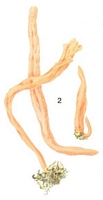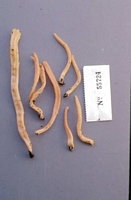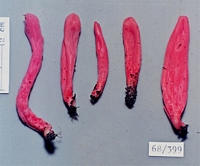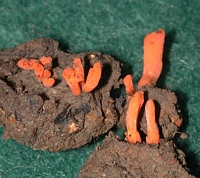|
 Clavaria sulcata Clavaria sulcata
SynonymsClavulinopsis sulcata
BiostatusPresent in region - Indigenous. Non endemic
Images (click to enlarge)
Caption: (2) Clavaria sulcata. Taylor no. 2227. | 
Caption: Microfiche 1-10. Clavaria sulcata. TENN no. 43561. | 
Caption: 68/399, id. R. Petersen, scale=20mm, NZ, NI, Puponga, among litter under Leptospermum scoparium, 09.05.1968, leg. EH
Owner: E. Horak | 
Caption: FUNNZ: 2006/0311, See public note for more information
Owner: FUNNZ | 
Owner: J.A. Cooper |
Article: Petersen, R.H. (1988). The clavarioid fungi of New Zealand. New Zealand Department of Scientific and Industrial Research, Bulletin 236: 170 pp. Wellington:.
Description: Fruit bodies up to 70 x 7 mm, simple clubs, solitary, gregarious or in groups of 2-3,
cylindrical to subclavate; consistency fleshy to fleshy-stringy. Stipe up to 20 x 5 mm, more
or less terete, rounded at base, with no mycelial pad, pale pinkish salmon below,
concolourous with club above, and not well set off from it. Club terete when young, inflating
irregularly during elongation to irregularly sulcate, wrinkled or ridged by maturity, appearing
waxy, fleshy pink to fleshy salmon ("bittersweet-orange", "peach-red", "light salmon-orange"); flesh bright, at first concolourous to
hymenium, in age more brightly coloured
("salmon-orange") just beneath hymenium; apex broadly rounded, subspathulate to
subturbinate in age, narrowly rounded" when young. Taste mildly of carrots, tardily bitter;
odour negligible.
Macro chemical reaction: FCL = negative.
Tramal hyphae of club 4-9 µm diam., hyaline, clamped, somewhat inflated, parallel, free, of
short cells, often anastomosing by "H"-connections. Subhymenium extensive, of tortuous,
uninflated, clamped hyphae. Hymenium thickening; basidia 65-85 x 7-9 µm, clavate,
clamped, persistent for some time after spore discharge; contents homogeneous, opalescent
by maturity and then sub refringent; sterigmata 4, very stout, up to 11 µm long, divergent,
nearly straight.
Spores 5.8-7.2 x 5.8-6.8 µm (E = 1.00-1.12; Em = 1.05; Lm = 6.50 µm), globose to
subglobose, thin-walled, opalescent; hilar appendix papillate, slender.
Notes: With personal experience, I can now comprehend van Overeem's (1923a,b) concept of
Clavaria sulcata as a bright salmon fleshy club. For many years I have treated the name as
belonging to a group including C. aurantio-cinnabarina, C. phoenicea, C. miyabiana Imai,
all of which produce narrowly fusiform or cylindrical, waxy-appearing fruit bodies with very
little sign of sulcation. Now, with the discovery of C. novo-zealandica and the specimens
cited below, a different alliance is revealed.
The reader must be cautioned that whereas my redescriptions of the type specimen of
Clavulinopsis sulcata (Petersen 1967b, 1980) were correct, and my transfer of the epithet to
Clavaria is still acceptable, my taxonomic treatment has been faulty. Likewise,
Comer's (1950, p. 379) depletion of "abnormally expanded fruit bodies" was on the mark for
normal fruit bodies, faithful to the type specimen, and his fruit body dimensions (up to 100 x
2-4 mm) were not true to the type, but typical of his concept and my own over the years.
The photographs of Clavaria taxa will confirm my description and commentary: the
differences between C. phoenicea var. persicina and C. sulcata are obvious in size and
stature, but in colour and micromorphology the taxa are similar. Again, some orangey-yellow
individuals of Ramariopsis simplex may also be mistaken for C. sulcata.
Horak's collection 68/399 from Nelson represents a brighter, more coral-red form, although
otherwise indistinguishable from normal C. sulcata. It may be seen as the upper figures in
the illustration of Ramariopsis ovispora.
Fruit bodies of Clavaria phoenicea var. persicina are similarly coloured when young, but
consistently are more peach or apricot, and remain narrowly cylindrical or fusiform
throughout their development. Likewise, fruit bodies of C. corallino-rosacea are similarly
coloured, but the species is easily separated on its elongate spores. Finally, Ramariopsis
laeticolor, of a more vivid or brash scarlet-orange, can be distinguished on its pear-shaped
spores, greening in FCL, and retention of colour on drying.
|